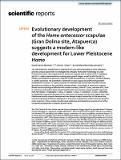Por favor, use este identificador para citar o enlazar a este item:
http://hdl.handle.net/10261/241646COMPARTIR / EXPORTAR:
 SHARE SHARE
 CORE
BASE CORE
BASE
|
|
| Visualizar otros formatos: MARC | Dublin Core | RDF | ORE | MODS | METS | DIDL | DATACITE | |

| Título: | Evolutionary development of the Homo antecessor scapulae (Gran Dolina site, Atapuerca) suggests a modern‑like development for Lower Pleistocene Homo |
Autor: | García-Martínez, Daniel CSIC ORCID; Green, David J.; Bermúdez de Castro, José María | Fecha de publicación: | 18-feb-2021 | Editor: | Nature Publishing Group | Citación: | Scientific Reports 11: 4102 (2021) | Resumen: | Two well‑preserved, subadult 800 ky scapulae from Gran Dolina belonging to Homo antecessor, provide a unique opportunity to investigate the ontogeny of shoulder morphology in Lower Pleistocene humans. We compared the H. antecessor scapulae with a sample of 98 P. troglodytesand 108 H. sapiens representatives covering seven growth stages, as well as with the DIK‑1‑1 (Dikika; Australopithecus afarensis), KNM‑ WT 15000 (Nariokotome; H. ergaster), and MH2 (Malapa; A. sediba) specimens. We quantified 15 landmarks on each scapula and performed geometric morphometric analyses. H. sapiens scapulae are mediolaterally broader with laterally oriented glenoid fossae relative to Pan and Dikika shoulder blades. Accordingly, H. antecessor scapulae shared more morphological affinities with modern humans, KNM‑WT 15000, and even MH2. Both H. antecessor and modern Homo showed significantly more positive scapular growth trajectories than Pan (slopes: P. troglodytes = 0.0012; H. sapiens = 0.0018; H. antecessor= 0.0020). Similarities in ontogenetic trajectories between the H. antecessor and modern human data suggest that Lower Pleistocene hominin scapular development was already modern human‑like. At the same time, several morphological features distinguish H. antecessor scapulae from modern humans along the entire trajectory. Future studies should include additional Australopithecus specimens for further comparative assessment of scapular growth trends. | Versión del editor: | https://www.nature.com/articles/s41598-021-83039-w | URI: | http://hdl.handle.net/10261/241646 | DOI: | 10.1038/s41598-021-83039-w | ISSN: | 2454-2156 | E-ISSN: | 2454-2164 |
| Aparece en las colecciones: | (MNCN) Artículos |
Ficheros en este ítem:
| Fichero | Descripción | Tamaño | Formato | |
|---|---|---|---|---|
| García_Martínez_D_Evolutionary.pdf | Artículo principal | 1,7 MB | Adobe PDF |  Visualizar/Abrir |
CORE Recommender
Page view(s)
74
checked on 24-abr-2024
Download(s)
112
checked on 24-abr-2024
Google ScholarTM
Check
Altmetric
Altmetric
Este item está licenciado bajo una Licencia Creative Commons

